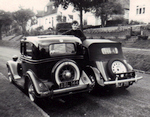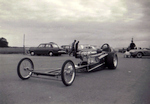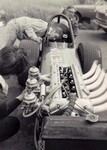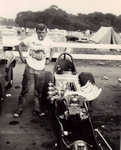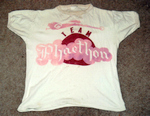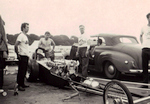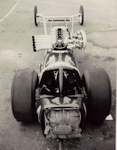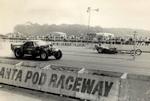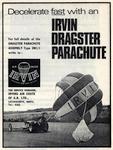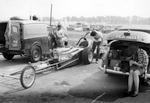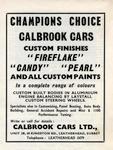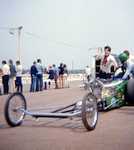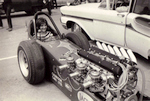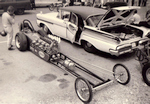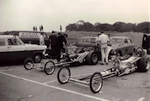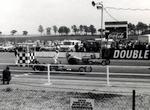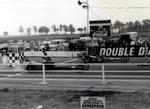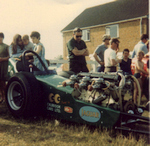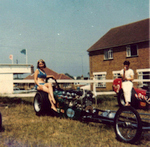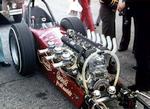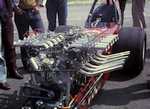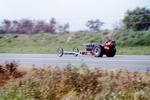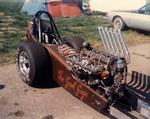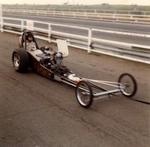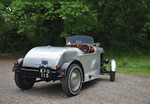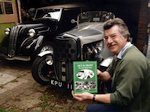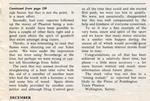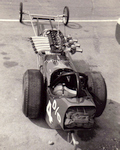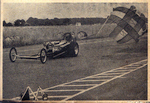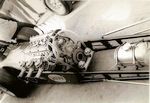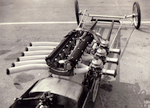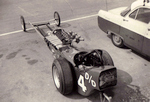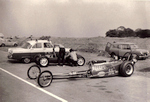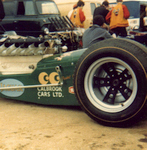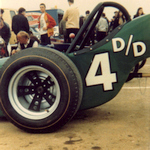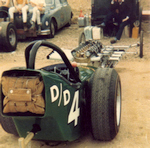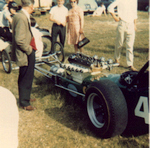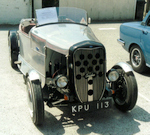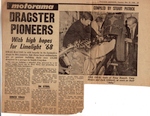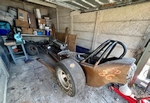
As told exclusively to Tony Russell started in the sport by joining a car club called the Road Runners in 1966. He encountered Team Phaeton and joined as they were building their Jaguar engined dragster which became Phaeton 1 and, later Limelight. The team ran the car until 1969, with some great experiences along the way. The buyer of Limelight was Jaguar specialist George Nolan who replaced the 6 cylinder engine with a V12 and renamed it Methsdrinker. After running it throughout the 1970s, George sold it to Steve Clarke and Nigel Rigden who reverted it to 6 cylinder power and named it The Good Guys. Meanwhile author Tony now runs a self built Ford roadster. During the mid 60s small groups of pioneering British enthusiasts were toiling away in workshops and garages across the country building the first British dragsters. 1966 saw several young hot rod enthusiasts from Purley, Surrey roaring around the streets in customised Ford 10s and Morris 8s. Customised to the extent of having removed the bonnets and exhaust silencers, cut down the front wings with hacksaws, painted the tyre side walls white and, in some cases, hand painted lurid flames and big fictional racing numbers on the bodywork. These cars were real Valspar and checker-tape jobs. They called themselves the Road Runners and were definitely not popular with parents or police. Leading the pack was one 21-year-old hot-blooded insurance clerk who shall remain nameless, and was of course hooked by the new sport of drag racing. It all started for me in 1959, when at the tender age of 13, I got hold of a copy of the American ‘Hot Rod Magazine’, first published in 1948. Secretly reading the publication under the lid of my desk I was fascinated by the strange and powerful cars described therein. My school exercise books were soon filled with drawings of those cars, much to the chagrin of my teachers, I had little interest in algebra, trigonometry or even worse, Latin, and so the flame was lit for a lifelong passion. My car was a Model Y Ford complete with home-made copper water pipe exhaust and motorcycle muffler. It had a remote gear change made out of Austin Seven bits, whitewalls painted on with Valspar and a Moon Equipped decal and bullet holes on the rear window.
One day I was burnt up by a small black Morris Minor van with oversize wheels on the back filling the wheel arches and what appeared to be Mini wheels on the front. The engine protruded a full foot from where the radiator grille should have been and what appeared to be drain pipe hung out the back of the van for the purposes of exhaust. As this outrageous vehicle out-dragged my Model Y, the driver gave me a friendly two-fingered wave, as one did, and I noticed a hand-painted sign on the van that said ‘Team Phaeton Drag Racing’. I had never heard of Team Phaeton but the drag racing bit looked very interesting so I gave chase. I followed the van up Purley Downs Road where it stopped outside a house in Sanderstead. It was a meeting of like-minded youngsters and the driver, a gentleman by the name of Tony Brown, invited me in to see a real dragster he was building in his mother’s garage. As he opened the doors I was totally and utterly sold, as there before my eyes was a half-built, long tubular-framed missile with skinny spoked front wheels, massive rear wheels, a tiny bucket seat right between them about a foot behind a gleaming Jaguar engine. The thing looked like 200 mph standing still.
We talked and talked and talked about drag racing and hot rods and eventually adjourned to the Royal Oak pub, still talking about our mutual interest. I had a foot in the door and offered to help with the build-up of the new dragster. After visiting the garage seven nights a week for some months and frequently falling asleep at my desk at the Legal & General Insurance Company at Kingswood the next day, from where I later got fired, I was formally invited to be the third member of one of England’s first drag racing outfits. The first member and our sponsor was Jack Stillwell who in fact ran a small temporary shop called ‘Stripside Stores’ at the new Santa Pod Raceway, selling T-shirts, decals, fuel and motor accessories etc. He also had a heroic capacity for booze but that is entirely another story. Work had started on the dragster in November 1965 when Jack and Tony began designing the chassis and bodywork. They prepared drawings for the frame and sent these away to Hawker-Siddeley for stress testing. Work continued throughout 1966 and we debuted the dragster at Santa Pod in 1967 calling it Phaeton 1. The following year the name changed to Limelight after the pearlescent lime green Metalflake paint job that was professionally applied by Calbrook Cars in Leatherhead for free in return for carrying their name on the body panels. For the technical bit, our car had a Reynolds 531 tubular chassis, about 13 feet long with a narrowed Austin A90 back axle solidly mounted. The front axle was chrome plated 1½” diameter tube with Ford Pop spindles, brakeless of course, and Honda 50 moped wheels. This was located by chrome radius rods and had about ½” of vertical movement from a Volkswagen torsion bar suspension unit. The engine was a twin overhead cam straight six Jaguar Mk1 2.4 litre bored out to 2.8 litre to run in the highly competitive under 3 litre class and also keep the motor nice and over square. We fitted a gas flowed head, triple 2” choke Stromberg carbs on a specially built manifold, race cams, specially made 10:1 pistons and every moving part of the engine was hand polished and lightened. I remember well taking 3 weeks to hand polish the crank and rods alone. The estimated bhp was approximately 230 although we never had the car on a rolling road as every firm we approached flatly refused to let us try the car out! Fuel was fed into a distribution chamber from a small 5-gallon aluminium tank in the nose of the car that was pressurised with a foot pump prior to each run. We ran it on methanol and the jets in the carbs were so big that someone once said it would be better to chuck a bucket of fuel at the engine.
The gearbox was standard Jag 4-speed with all the guts removed but for third and top. There was no prop-shaft as directly behind the gearbox and right between your legs was a universal joint that splined directly on to the pinion of the A90 axle. Needless to say, there was a hefty ¼” plate scatter shield all around the revolving transmission bits and we sat behind the diff with legs hooked over the axle casing. Controls were simple, loud pedal on the right and clutch on the left of the bell housing. No fancy links or hydraulics were used, the clutch pedal was pinned directly on to the cross shaft. As you can imagine, a pretty strong left leg was needed to depress the E-type diaphragm unit and it was either in or it was out. Steering was taken care of by a small aluminium butterfly wheel connected to a Standard 10 steering box mounted upside down under the dash panel with a drop arm down to a long steering link to the front wheels some 10 feet away. A short stubby 3” gear lever was mounted on the top of the diff casing with a remote link to the gearbox. On the dashboard was a fuel-on lever with a cable to a valve that released the pressurised fuel distribution block underneath the carbs. There was a magneto switch marked ‘run’ and ‘off’.
A brake lever on the right of the driver’s seat linked directly into the master cylinder to operate the rear wheel brakes only. Over our right shoulder was the parachute release lever that had a short Bowden cable with a pin that released a small drogue chute followed, hopefully, by a 10-foot cruciform Irving parachute that was specially made for us by Irving in return for having their name in big letters on the parachute. There was a central rev counter red-lined at 7500 and an oil pressure gauge and that was it. Before each run a complete visual check of the rail was made, we looked for any loose connections, bolts, linkages etc. Dragsters take a real pounding during a run and safety was always paramount. A couple of gallons of Methanol were poured into the tank which was then pressurized with a car tyre foot pump via a Schraeder valve. We did not run a radiator in competition, but we filled the block with water via a chromed filler tube that was fitted where the engine top hose used to be located. The push car then came up behind and pushed the rail forward in gear with the ignition and fuel switches off. When the oil pressure came up, the ignition and fuel were activated in that order. We used to start her in the old fire up road that ran parallel to the beginning of the strip, spectators got really close in those days and loved to watch the dragsters start up. With luck she lit up immediately and the six open pipes emitted an ear-splitting crackle, not far from your left ear. The rail was taxied round behind the control tower and up to the line. We always hoped that our competitor got staged before our engine cooked. When both cars were staged, there was about a 15 second wait, and during this time a second visual check was made. This was one of my jobs. I recall that two yellows at the top of the Christmas Tree meant that both cars were properly staged. The lights came down the tree one by one, with two ambers followed by a green. On the second amber, hold the revs up at about 4000, right on the cam, with the car in gear, clutch down, steadying her on the manual brake lever with your right hand. It was always best to allow the smallest amount of drag on the clutch to wind up the transmission, if this was not done the enormous shock load when the clutch was dropped would invariably break something. On the green, drop the clutch and floor the accelerator, hoping that she would not bog off the line. Many early drivers made the mistake of blipping the throttle for effect before launch, they were often caught out off the cam when the green arrived. I only drove the dragster once in competition as she was really Tony Brown and Jack Stillwell's car, and Tony always was the driver. I will recount that drive, probably the most exciting thing that a 21-year-old could do, (almost!) It ran bullet straight, but huge concentration was required. The acceleration on the first 30/50 yards was phenomenal. I was pinned back into the tiny bucket seat, holding the car straight with the aluminium butterfly steering wheel. Right foot never came up off the floor for the whole run. When the revs came back to peak, I think that was about 7500, about 150 yards out, a power on clutchless gear change was made straight back into top gear. The trick was to keep the engine at peak power all the way down the track. The last two thirds of the run were just a very noisy, bumpy blur with rapidly increasing speed until you saw the markers that indicated the end of the measured 1/4 flash past. As soon as you saw the finish line markers the procedure was magneto switch off, fuel cut off lever activated and let the speed drop to about 60 mph before gently nudging the brake lever. It was a very bad idea to lean on the brake at top speed as with rear wheel brakes only you ran the risk of de-stabilising the car. The 'chute was not always used, but Tony deployed it on several occasions, it did make the tail of the car very light when it came out. The return run back down the strip being pushed by the push car was all part of the theatre. My time for that run was in the low 12's with a terminal of over 100 mph. Sadly I lost my timing slip many years ago! Great days and a never to be forgotten experience. Video: Phaeton 1 drops the laundry One of my duties was parachute packing and I well remember Tony making a particularly fast run and then rapidly disappearing into the fields off the end of the track. He said I packed it badly, I said he forgot to pull the release ring firmly enough. Anyway, it didn’t deploy properly and Tony ended up half a mile away parked sizzling and bubbling in a field full of terrified pigs that had bolted off in all directions when they saw this missile heading towards them. I got a terrible bo****king from sponsor and driver as we had to wade through half an acre of mud to retrieve the car which by that time was liberally plastered with pig s**t. Half-shafts would let go at regular intervals and we always carried a stock of them in the back of the van. That was until we installed a narrowed Ford Transit axle with EN24T shafts made by Bootsie Herridge. We never broke one of those but we actually used to wind the splines a bit and somewhere in the back of my workshop I still have a half-shaft with nearly 60 degrees of twist on the splines.
Our Morris Minor van was legendary. Tony Brown had fitted a BMC B series engine in it and I remember many times, towing up the M1 and overtaking cars at 60 plus. I will never forget the looks on other driver’s faces as they were overtaken by a little black Morris Minor van followed by amazement as they then saw a huge 4-wheeler trailer with a dragster on it hooked behind the van! When we had completely worn out the van, our sponsor bought us an Austin Westminster A110 which was much better not only for towing but we could also get more girls in the back seat and on occasions in the boot. This was when the Santa Pod owners had the temerity to start charging the 7/6d public entrance fee for passengers in competitor’s tow cars. After all, the girls were crew members, of a sort.
There was one particular meeting that we entered and we managed to bend a valve late one afternoon and because we were intending to race the next day it was decided to strip the top end of the engine overnight and attempt to repair the damage. Well, we got the head off and got the offending valve out. Tony and I were working at midnight with a club hammer and a set of files straightening the valve over a gate post. It all went back together again and the car performed admirably the next morning. One memorable occasion back in Sanderstead, we had just reset the timing and were desperate to try it out prior to a race meeting the next day at Santa Pod. It was about 10.30pm and we made the decision to fire up the dragster in the road outside Tony’s parent’s house. You know it was a very nice polite tree-lined quiet residential sort of area so, with Tony in the hot seat, I push started the car which instantly lit up with the unmistakable crackling roar of a highly tuned, unsilenced racing engine and an over-run like an Ack-Ack gun. The car was given a bootful down the quiet residential road and then rapidly shut off and frantically pushed back into the garage where we hid with the lights out convulsed with silent mirth tinged with apprehension as rather predictably 5 minutes later a small fleet of police panda cars and LE Velocettes cruised around the neighbourhood in response to a flood of telephone calls from highly alarmed and extremely annoyed neighbours. We got away with that one with a sound ticking off and a mini-lecture on consideration for neighbours as nobody had actually seen the car run. They only heard it.
We continued to live for drag racing and all that it stands for till the end of 1969. Sadly, Limelight never realised our expected potential of 150mph in 10 seconds. This was not for lack of trying as we always raced to win and if something broke it just wasn’t strong enough. Writing was already on the wall late 1969 when our sponsor began to draw in the purse strings as there was simply not enough money left for the engine and transmission developments that Tony and I so badly wanted. Some of our competitors had attracted sponsorship from major companies but try as we did, we could not get the financial backing needed. We sold the car, custom built trailer and equipment including a spare engine and Marshall super-charger that we couldn’t afford to fit. The money was split three ways, our sponsor Jack Stillwell paid back some of his accumulated debts, Tony Brown built a BMW powered ski boat and interestingly enough developed his career with BOAC and went on to be a flight engineer on Concord. With my smaller share I bought a 250cc racing go-kart and had a lot of fun with that for a couple of years. The buyer for Limelight was a Jaguar specialist in South London known as George Nolan. Alan Sharpe drove the car which was renamed Methsdrinker initially with a straight six then in 1974 this was swapped for an impressive Tecalemit-Jackson injected V12 with Jim Tester cams. This ran throughout the 70s getting down to low 10s at 140mph before being sold again, ending up with Steve Clarke and Nigel Rigden who ran it in the mid 80s at Long Marston, Blackbushe and Santa Pod with an injected methanol burning 3.8 Jag. They renamed it The Good Guys. Then after a piston hit a valve at North Weald the car got laid up, life got in the way and it wasn’t till 2021 that they came back out with a blown Rat powered Topolino running with the Supercharged Outlaws. As for the slingshot... yes, they still have it.
Nowadays I drive my home built 1172cc Ford roadster, ‘Spirit of the Forties’. Chassis is from a 1946 Ford Anglia van, boxed, braced with lowered floor and spreader bars. Engine is a 1172cc Ford 10 with high compression head, twin SU carbs on an Aquaplane manifold and the block is ported and polished. Transmission is Ford 10 three speed box with high ratio 4.7:1 rear end. Body is hand-built aluminium over traditional Ash and ply frame, a scaled down '32 Ford. (To fit British chassis rails) Interior has aircraft style bucket seats from an Austin 7 Ulster, re-covered in Connolly leather and central throttle pedal with no room inside the cockpit to mount it on the right. I also have a super rare 1937 7W Ford 10 Tourer. I am the author of the book ‘Out in Front’, The Leslie Ballamy Story which was published in 2004, a must-read for anyone interested in early Ford and Austin Specials...
Gallery: click on any thumbnail for a large image.
Back to pioneers index Back to News page |






































